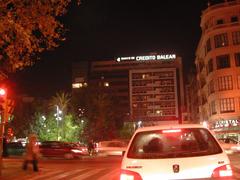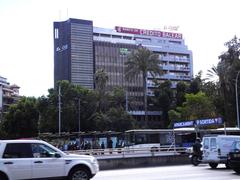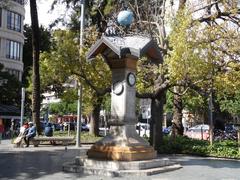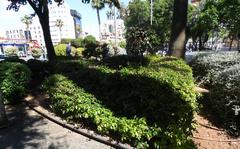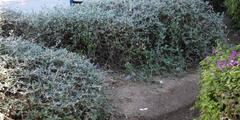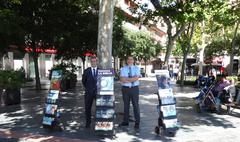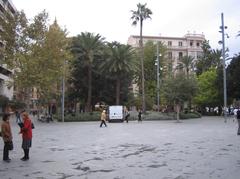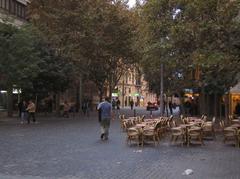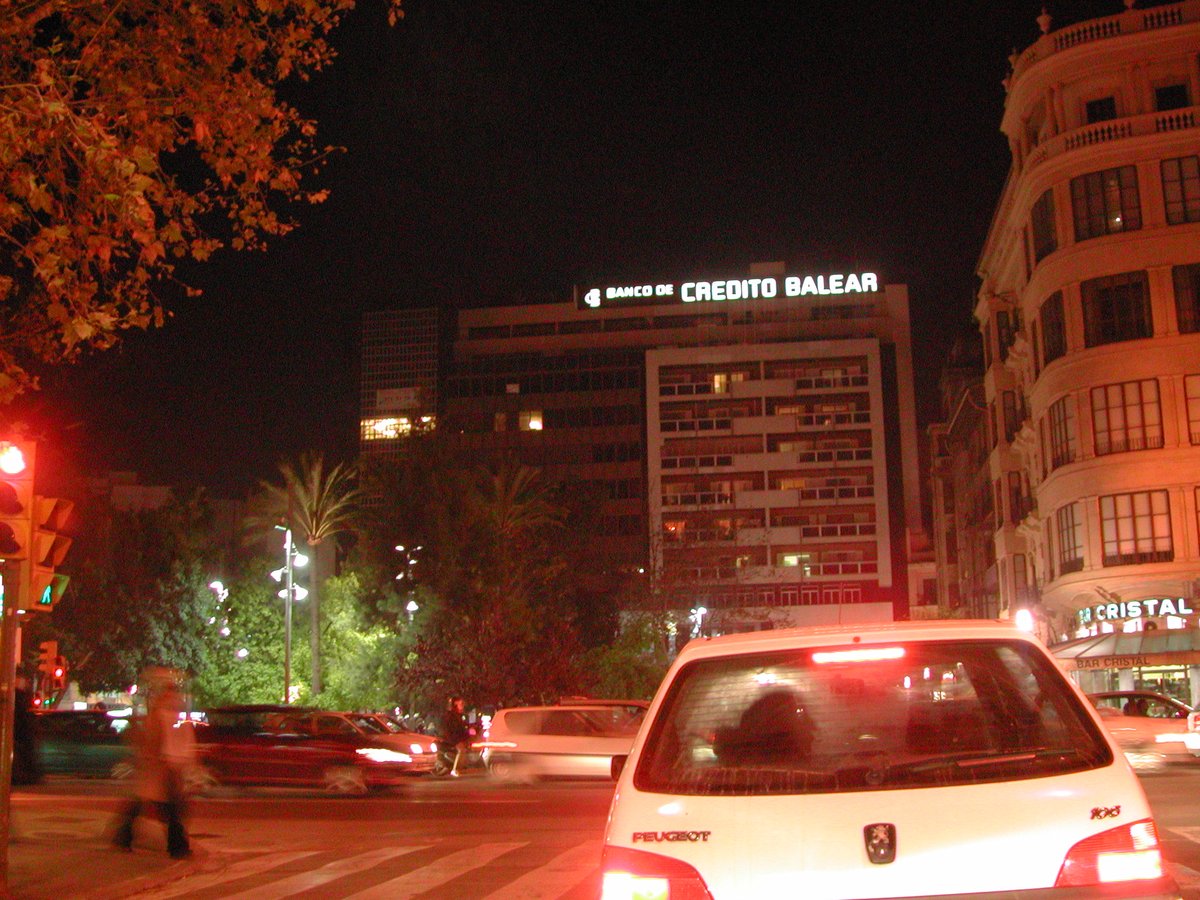
Visiting Plaça d’Espanya, Palma, Spain: Guide, Tickets, Hours, and Attractions
Date: 15/06/2025
Introduction to Plaça d’Espanya, Palma, Spain
Nestled in the heart of Palma, Mallorca, Plaça d’Espanya is a dynamic crossroads that fuses the city’s rich historical legacy with its vibrant modern life. This iconic square, originally established in the 17th century as the entryway outside Palma’s Renaissance walls, has transformed over centuries into a bustling transportation hub and cultural gathering point (Plaça d’Espanya Wikipedia (Catalan)). With its blend of architectural styles, central monument, and proximity to key attractions, Plaça d’Espanya is an essential stop for travelers exploring Palma’s unique character.
At the square’s core stands the renowned equestrian statue of King Jaume I, commemorating the 1229 conquest that profoundly influenced Mallorca’s identity. The plaza’s configuration—spanning the historic triangular Plaça de la Porta Pintada and the adjacent modern rectangular section—embodies the city’s evolution from medieval stronghold to contemporary metropolis (Nomads Travel Guide).
As a lively social arena, Plaça d’Espanya hosts cultural events, markets, and public gatherings that reflect Palma’s traditions and diversity. Its location makes it a springboard for exploring nearby highlights such as Mercat de l’Olivar, Palma Cathedral (La Seu), and the charming old town (Lonely Planet). This guide provides practical information, historical context, and insider tips to help you make the most of your visit.
Contents Overview
- Discover Plaça d’Espanya: Palma’s Vibrant Historic Square
- Quick Visitor Information
- Historical Overview: From Fortified Walls to Urban Landmark
- Architectural Highlights and Urban Significance
- Practical Visitor Tips
- Cultural and Social Role
- Recent Renovations and Future Outlook
- Frequently Asked Questions (FAQs)
- Key Attractions at Plaça d’Espanya
- Activities for Visitors
- Practical Visitor Information
- Nearby Points of Interest
- Cultural Insights
- Summary and Final Tips
Discover Plaça d’Espanya: Palma’s Vibrant Historic Square
Plaça d’Espanya is the city’s main urban square, offering a unique blend of historic resonance and contemporary vitality. Its dual function as a landmark and major transportation interchange makes it a focal point for both tourists and locals.
Quick Visitor Information
- Location: Central Palma, Mallorca
- Visiting Hours: Open 24/7
- Entry Fee: Free
- Accessibility: Fully accessible, with ramps and smooth surfaces. Nearby Estació Intermodal provides step-free transit connections.
- Transportation: Connected to metro, EMT city buses, and intercity buses via Estació Intermodal beneath the plaza
- Best Time to Visit: Early morning or late afternoon for ideal lighting and fewer crowds
Historical Overview: From Fortified Walls to Urban Landmark
The origins of Plaça d’Espanya date to the 17th century, when it was known as Plaça de la Porta Pintada, positioned just outside Palma’s Renaissance-era city walls. The demolition of these walls in 1902, following the Plan Calvet reforms, paved the way for the modern rectangular plaza adjacent to the original triangular space.
Over time, the square’s name evolved, echoing shifts in the city’s political and social landscape: from Plaça de Joanot Colom to Plaça d’Eusebi Estada, and finally Plaça d’Espanya in 1936 (Plaça d’Espanya Wikipedia (Catalan)). The historic triangular section still bears the name Plaça de la Porta Pintada, honoring its medieval roots.
Architectural Highlights and Urban Significance
Plaça d’Espanya’s dual layout links Palma’s medieval past with its urban present. The square connects major avenues such as Avinguda d’Alexandre Rosselló and Carrer d’Eusebi Estada, and sits adjacent to Parc de les Estacions.
The centerpiece is the equestrian statue of King Jaume I, which serves as both a cultural emblem and a popular photo spot. The surrounding architecture reflects a mix of early 20th-century and modern styles, framing the plaza’s lively atmosphere.
Practical Visitor Tips
- Getting There: Arrive via Estació Intermodal, accessed by metro line M1, multiple EMT city bus lines, and intercity buses.
- Accessibility: The square and public transport are wheelchair-friendly.
- Nearby Attractions: Mercat de l’Olivar, Parc de les Estacions, and bustling streets like Sant Miquel offer excellent additional experiences.
- Guided Tours: City walking tours frequently include Plaça d’Espanya; check Palma tourism sites for options.
- Photography: Early mornings and late afternoons have the best natural light.
Cultural and Social Role
Plaça d’Espanya is a central stage for Palma’s public life, hosting events, markets, and demonstrations such as the 2011 “15-M” Indignados protests. Its benches, green spaces, and proximity to cafés make it a favorite meeting and relaxation spot for residents and visitors alike.
Recent Renovations and Future Outlook
A major renovation beginning in 2023, with a €2.5 million investment, aimed to improve safety and aesthetics. Upgrades include new slip-resistant paving, modernized lighting and benches, enhanced water features around the Jaume I statue, and advanced drainage systems. These changes preserve the plaza’s historic character while making it safer and more welcoming (Mallorca Magazin on renovations).
Frequently Asked Questions (FAQs)
Q: Is there an entrance fee to visit Plaça d’Espanya?
A: No, the plaza is a public space and free to visit at any time.
Q: Are there guided tours available?
A: Yes, many walking tours of Palma include Plaça d’Espanya. Check local tourism offices or online booking sites.
Q: Is the square wheelchair accessible?
A: Yes, Plaça d’Espanya and its transport facilities are wheelchair-friendly.
Q: What nearby attractions can I visit after Plaça d’Espanya?
A: Mercat de l’Olivar, Parc de les Estacions, and the streets of Palma’s historic center are all close by.
Key Attractions at Plaça d’Espanya
Central Monument and Urban Design
The equestrian statue of King Jaume I is the square’s iconic centerpiece, honoring the 13th-century conquest that shaped Mallorca’s history. The plaza’s open, landscaped design—with benches and shaded areas—makes it inviting for relaxation and people-watching (Nomads Travel Guide).
Transportation Hub
Plaça d’Espanya is Palma’s main transit nexus. The Estació Intermodal beneath the plaza connects the city’s metro, bus, and train networks, making it easy to reach destinations across the island. The historic Sóller Railway, departing from a nearby station, offers scenic trips into the Tramuntana mountains (Voyage Tips).
Architectural Highlights and Surroundings
Surrounding the square are avenues and pedestrian streets such as Avinguda d’Alexandre Rosselló, Carrer de Sant Miquel, Avenida Joan March, Eusebio Estada, and La Rambla. These routes lead to shopping, dining, and local attractions (Nomads Travel Guide).
Mercat de l’Olivar
A short walk from the square, Mercat de l’Olivar is Palma’s premier indoor food market, renowned for fresh produce, seafood, tapas, and Mallorcan specialties. It is open Monday to Saturday, with extended hours on Fridays (Lonely Planet).
Proximity to Palma’s Old Town
From Plaça d’Espanya it’s easy to explore the medieval core of Palma, including Palma Cathedral (La Seu), Plaça Major, and Basilica de Sant Francesc. These sites offer insight into the city’s rich history and architectural splendor (Sunshine Seeker, Voyage Tips).
Activities for Visitors
- People-Watching: The plaza’s lively ambiance makes it ideal for observing local life.
- Guided and Self-Guided Tours: Several companies offer themed walking tours starting at or passing through the square (GPSmyCity).
- Shopping: Enjoy nearby boutiques, the El Corte Inglés department store, and artisan shops.
- Dining: Sample local cuisine at cafés, bakeries, and the Mercat de l’Olivar.
- Events: Experience open-air concerts, seasonal markets, and festivals like Sant Sebastià.
- Day Trips: Use the square’s transport connections for journeys to Sóller, mountain villages, or beaches (Lonely Planet).
Practical Visitor Information
Visiting Hours and Tickets
- Plaça d’Espanya: Open 24/7, free entry.
- Nearby Sites: Individual attractions may have ticketed entry and specific hours; check official sites for details.
Accessibility
- Fully accessible, with ramps and smooth paths.
- Public transport from the square accommodates persons with reduced mobility (Palma tourism official site).
Parking
- Large underground car park available (approx. €2/hour as of 2025). Early arrival is advised during peak periods (Voyage Tips).
- Public transport is recommended due to limited central parking.
Safety
- The plaza is generally safe, with routine police presence.
- Remain vigilant against pickpocketing, especially during busy events (Voyage Tips).
Currency and Payments
- Euro (€) is the official currency.
- Cards widely accepted; carry some cash for small purchases (Sunshine Seeker).
Amenities
- Restrooms: Located within Estació Intermodal and nearby venues.
- Luggage Storage: Available at Estació Intermodal.
- Wi-Fi: Free public Wi-Fi in parts of the plaza and station.
- Tourist Offices: Near the square for maps and advice.
Nearby Points of Interest
- El Corte Inglés: Shopping and dining.
- La Rambla: Leafy boulevard with flower stalls.
- Carrer de Sant Miquel: Pedestrian shopping street.
- Mercat de l’Olivar: Vibrant food market.
- Palma’s Old Town: Medieval streets, museums, and cultural sites.
Cultural Insights
Plaça d’Espanya encapsulates the spirit of Palma—serving as a venue for civic life, celebrations, and daily routines. The square’s social diversity and architectural variety mirror the city’s cosmopolitan energy, making it a microcosm of Mallorca’s capital (Nomads Travel Guide).
Summary and Final Tips for Visiting Plaça d’Espanya, Palma
Plaça d’Espanya is the gateway to Palma’s past and present, offering seamless access to historic sites, vibrant markets, and local events. Recent renovations have improved safety and comfort, ensuring the square remains welcoming and accessible. Whether you’re embarking on a guided tour, sampling Mallorcan cuisine, or relaxing in the plaza’s open spaces, this central hub is an indispensable part of any Palma itinerary (Mallorca Magazin on renovations).
For updated travel advice, interactive maps, and event listings, consult the official Palma tourism website. Enhance your Palma experience with the Audiala app and stay connected for exclusive tips and offers.
Sources and Further Reading
- Plaça d’Espanya Wikipedia (Catalan)
- Mallorca Magazin on renovations
- Palma tourism official site
- Nomads Travel Guide
- Lonely Planet
- Sunshine Seeker
- Voyage Tips
- GPSmyCity
